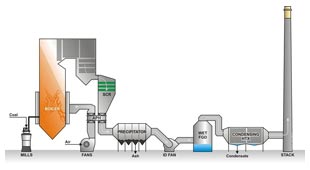Lehigh University
P.C. Rossin College of Engineering and Applied Science
Condensing Heat Exchangers for Heat and Water Recovery
Coal fired power plants have traditionally operated with stack temperatures in the 300 F range to minimize fouling and corrosion problems due to sulfuric acid condensation and to provide a buoyancy force to assist in the transport of flue gas up the stack. However, as an alternative, there could be significant benefits to cooling the flue gas to temperatures below the water vapor and acid dew points. (Depending on coal rank and on whether or not a wet flue gas scrubber is used, water vapor begins condensing in boiler flue gas at temperatures below approximately 135 F.) The condensed water vapor would provide a source of water for use in power plant cooling; recovered latent and sensible heat could be used to reduce unit heat rate; condensation of acid in a controlled manner would reduce the flue gas acid content and provide environmental, operational and maintenance benefits; and the reduced flue gas temperature would promote increased removal of mercury and other air toxics.
Funded by DOE and industry, a team of researchers from the Energy Research Center has been developing condensing heat exchanger technology for application to coal-fired power plants. The team members have designed, fabricated and field tested condensing heat exchangers using slip streams of flue gas from scrubbed and unscrubbed coal-fired boilers. They’ve performed analyses to estimate potential water vapor recovery rates and heat rate reductions which would result from separating water vapor from boiler flue gas in condensing heat exchangers, and they’ve developed full-scale designs of condensing heat exchangers for use in large coal-fired power plants.
From research conducted by the ERC team, it has also been shown that condensing heat exchangers can reduce emissions of gas phase mercury from the stack.
In pilot scale slip stream tests of a CHX carried out by Lehigh researchers, percentage capture of total Hg in the flue gas occurring within the CHX ranged up to 80 percent, with the capture percentage varying with CHX configuration and process conditions and possibly with flue gas composition. Computer simulations carried out by the researchers have identified low temperature mercury-chlorine reactions as being responsible for the enhanced Hg capture.
Finally, there are also potential applications of condensing heat exchangers with carbon capture and sequestration systems (CCS). Some types of post-combustion CO2 scrubbers require inlet flue gas temperatures below 100°F for efficient operation, and the types of heat exchangers developed and tested by the Lehigh team are candidates for use in pretreating boiler flue gas before it flows into a post combustion CO2 capture system.
Related Links:
